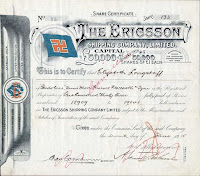Old share certificates from shipping and fishing companies often depict their company flag. This 1913 share from the Compañia Trasatlantica is not an exception thereon. The company’s flag in the upper border is an eye-catcher as the company’s monogram is embossed upon the same blue-printed monogram in the center of the flag. As a result you see the flag in some kind of relief.
Acción Preferente 500 Pesetas, Barcelona 1913
notice the flag in underprint on the certificate's image
large format certificate: upper & lower half digitally pasted
There is also a flag printed in the right border below, and one in the underprint. Oddly, the latter two flags are missing the monogram and that is why I initially felt that the design was somehow incomplete : why is the monogram missing in the other flags ? Later on, it turned out that I was wrong about that.
We know the Romans used flags on their legion standards. And long before the Romans, the Chinese already used flags for militiary purposes. Since Antiquity, flags were used on merchant ships. Initially designed for nations, flags were used for separate army regiments in the late Middle Ages. From the 17th century, the age of colonization and naval battles, it became more customary – and later a legal requirement - for ships to carry flags indicating their nationality. This nation flag is called an ensign flag. Many variants can exist depending on the occasion, such as when going at war.
Share (upper half) of the Ulabrand company
Tönsberg (Norway), 1918
From the 19th century, merchant ships fly an additional flag identifying the company that owns the vessel. Such a flag is called the company’s house flag. The way flags on vessels are used is subject to many rules and regulations. An example, the fact that a ship does not fly the flag of the nation it is visiting, can be seen as a provocation.
Shares of 1 Pound, 1915, The Ericsson Shipping Company, Ltd
Exceptional boat structure vignette (click image to enlarge)
Exceptional boat structure vignette (click image to enlarge)
Hence, on an open sea or moored in a crowded harbour, a ship must be quickly and easy identifiable. An efficiant flag design helps to achieve that goal . Often the ships funnels show corresponding colors and patterns to serve the same purpose. These are good flag design principles (Ted Kaye, N.A.V.A.) :
- Keep It Simple: A child should be able to draw the flag from memory.
- Use Meaningful Symbolism: Flag's images, colors, or patterns should relate to what it symbolizes.
- Use Three Basic Colors: A limited number of standard colors on the flag contrast well
- No Lettering or Seals
- Be Distinctive or Be Related: Do not duplicate another flag. Similarities show connections with other related flags.
Compagnie Générale d'Outre-Mer
Action de 100 Francs, 1924
click to enlarge images
click to enlarge images
Now back to our Trasatlantica share certificate. While researching this company on the Internet, I tumbled in this page (click) where the house flag of the Compañía Trasatlántica Española is shown : blue with a white disc in the middle.
Aha ! The correct flag was a flag without a monogram, which corresponds to good flag design principles. Obviously, I was wrong about that monogram. Only much later, I discovered other Trasatlantica certificates from the 1940s depicting a blue flag with a white disc.
This share left me another surprise in regards of its flag. It has a remarkably large watermark of the house flag.
When holding against a light source,
a watermark of the flag appears measuring about 12cm x12cm
The Latin word vexillum means flag. The study of flag design and usage is called vexillology.
More interesting reading material about this topic and the history of the Compañia Trasatlantica can be found on the following web resources :
- House flags of shipping companies
- Funnels, Flags, and Night Signals of the Transatlantic Lines
- Flags of the World
- Compañia Transatlantica Española
- Flags of shipping companies with wrecks
F.L.
Embossed seal depicting sailing ship,
yet another feature near the lower border at the left.
(click image to enlarge)













Author's note : external link added to the WRECK Site showing plenty of flags of shipping companies with wrecked ships.
ReplyDelete